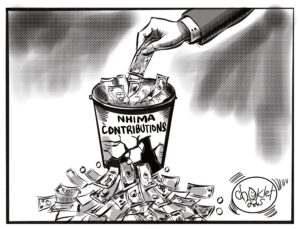ENERGY Minister Matthew Nkhuwa says he hopes that Zambia’s load shedding will be mitigated by end of December, 2020, mainly as a result of increased water levels at the Kariba Dam.
And Nkhuwa has dismissed claims suggesting that government has taken over the operations of Copperbelt Energy Corporation (CEC).
Speaking at a joint-press briefing in Lusaka, Wednesday, Nkhuwa said the water levels at Kariba Dam had improved in recent months, adding that the Kafue Gorge is also expected to start generating electricity by August, this year, which is expected to significantly reduce load shedding hours across the country by December, 2020.
“During the period of 1st May to 15th June, the average generation of electricity was 1,780 megawatts, which comprised 1,379 megawatts from Zesco, and 401 megawatts from Independent Power Producers (IPPs). The reduction in the IPP was due to the non-availability of heavy fuel from Ndola Energy and non-availability of Lusemfwa Hydro Power Plant, which is being shared because of very little water there. The power deficit stands at 810 megawatts and the load shedding for 10 hours is being currently out for different customer categories under distribution. Going forward, by August-September, the Kafue Gorge Lower (Hydropower Project) will come into play and by the end of December, we should have 750 megawatts. So, this deficit will be reduced considerably and as we get into the New Year, this issue of power should have been mitigated,” Nkhuwa said.
He said the water levels at Kariba Dam had improved due to increasing inflows recorded in Chavuma as well as the stabilization in the Barotse Plains.
“Zesco is mandated to offer support to neighbouring countries. Currently, our commitment stands at 190 megawatts. At Kariba North Bank, the dam levels have continued to rise due to increasing inflows as recorded at Chavuma merging point and also the stabilization in the Barotse Plains in Western Province. As of today, we had 40 per cent of the dam full,” Nkhuwa said.
And Nkhuwa said CEC still remained a privately-owned power utility.
“CEC remains a Zambian private company that is listed in the Lusaka Stock Exchange (LuSE) and has not been nationalized or expropriated by the government. Infrastructure remains that of CEC, while the same will be used as a common carrier of power. As a government, we are proud of CEC and its achievement in the recent past and its critical role it continues to play in the Zambian electricity market. CEC has been supplying electricity to KCM on the Copperbelt and the contract between the two parties came to an end on 31st May, 2020. Prior to the expiration of the Power Supply Agreement (PSA), KCM formally wrote to CEC informing them of the intentions not to renew the Power Supply Agreement,” he said.
“Preceding the expiration and notification to CEC, the mining company, KCM, engaged Zesco to enter into a success agreement that would ensure continuous flow of power. This power is produced by Zesco. I must put it on record that CEC has got a solar power plant, which is located in Kitwe and it only produces one megawatt. So, they don’t produce electricity.”
He also said that KCM had made a payment to CEC against its outstanding debt of US$142 million owed to the Kitwe-based utility for the power supplied.
“As you may be aware, KCM has an outstanding debt of US $142 million owed to CEC as at 31st May, 2020. I am aware that KCM, during its receivership period, made a payment of US $46 million to CEC. On 1st June, 2020, CEC board of directors collectively decided to restrict power to KCM due to arrears owed by KCM. The matter was discussed with CEC in order to continue supplying power to KCM. On 3rd June, 2020, CEC confirmed the continued power supply by Zesco to KCM using CEC infrastructure,” said Nkhuwa.























